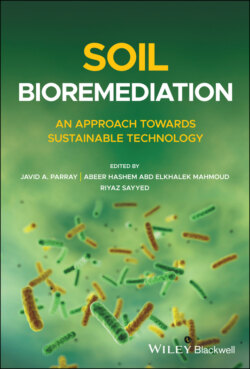Читать книгу Soil Bioremediation - Группа авторов - Страница 59
References
Оглавление1 1 Illanes, A., Cauerhff, A., Wilson, L. et al. (2012). Recent trends in biocatalysis engineering. Bioresource Technology 115: 48–57. https://doi.org/10.1016/j.biortech.2011.12.050.
2 2 Nigam, P.S. (2013). Microbial enzymes with special characteristics for biotechnological applications. Biomolecules 3 (3): 597–611.
3 3 Gurung, N., Ray, S., Bose, S. et al. (2013). A broader view: microbial enzymes and their relevance in industries, medicine, and beyond. Biomed Research International 2013: 329121.
4 4 Rodríguez Couto, S. and Herrera, J.L.T. (2006). Industrial and biotechnological applications of laccases: a review. Biotechnology Advances 24 (5): 500–513.
5 5 Gianfreda, L., Xu, F., and Bollag, J.M. (1999). Laccases: a useful group of oxidoreductive enzymes. Bioremediation Journal 3 (1): 1–25.
6 6 Thurston, C.F. (1994). The structure and function of fungal laccases. Microbiology 140: 19–26.
7 7 Arora, D.S. and Sharma, R.K. (2010). Ligninolytic fungal laccases and their biotechnological applications. Applied Biochemistry and Biotechnology 160: 1760–1788.
8 8 Imran, M., Asad, M.J., Hadri, S.H. et al. (2012). Production and industrial applications of laccase enzyme. Journal of Cell and Mollecular Biology 10 (1): 1–11.
9 9 Sharma, P., Goel, R., and Caplash, N. (2007). Bacterial laccases. World Journal of Microbiology and Biotechnology 23: 823–832.
10 10 Brijwani, K., Rigdon, A., and Vadlani, P.V. (2010). Fungal laccases: production, function, and applications in food processing. Enzyme Research 2010: 149748.
11 11 Bugg, T.D., Ahmad, M., Hardiman, E.M. et al. (2011). The emerging role for bacteria in lignin degradation and bio‐product formation. Current Opinion in Biotechnology 22 (3): 394–400.
12 12 Harms, H., Schlosser, D., and Wick, L.Y. (2011). Untapped potential: exploiting fungi in bioremediation of hazardous chemicals. Nature Reviews in Microbiology 9 (3): 177–192.
13 13 Reiss, R., Ihssen, J., and Thöny‐Meyer, L. (2011). Bacillus pumilus laccase: a heat stable enzyme with a wide substrate spectrum. BMC Biotechnology 11: 9.
14 14 Kunamneni, A., Plou, F.J., Ballesteros, A. et al. (2007). Laccases and their applications: a patent review. Recent Patents on Biotechnology 2008 (2): 10–12.
15 15 Bressler, D.C., Fedorak, P.M., and Pickard, M.A. (2000). Oxidation of carbazole, N‐ethylcarbazole, fluorene, and dibenzothiophene by the laccase of Coriolopsis gallica. Biotechnology Letters 22 (14): 1119–1125.
16 16 Pointing, S.B. (2001). Feasibility of bioremediation by white‐rot fungi. Applied Microbiology and Biotechnology 57 (1–2): 20–33.
17 17 Niku‐Paavola, M.‐L. and Viikari, L. (2000). Enzymatic oxidation of alkenes. Journal of Molecular Catalysis B 10 (4): 435–444.
18 18 Viswanath, B., Rajesh, B., Janardhan, A. et al. (2014). Fungal laccases and their applications in bioremediation. Enzyme Research 2014: 1–21.
19 19 Banat, I.M., Nigam, P., Singh, D. et al. (1996). Microbial decolorization of textile‐dye‐containing effluents: a review. Bioresource Technology 58: 217–227.
20 20 Zollinger, H. (2002). Synthesis, Properties and Applications of Organic Dyes and Pigments. New York;: Wiley.
21 21 Setti, L., Giuliani, S., Spinozzi, G. et al. (1999). Laccase catalyzed‐oxidative coupling of 3‐methyl 2‐benzothiazolinone hydrazone and methoxyphenols. Enzyme and Microbial Technology 25 (3–5): 285–289.
22 22 Raghukumar, C. (2000). Fungi from marine habitats: an application in bioremediation. Mycological Research 104 (10): 1222–1226.
23 23 Bajpai, P. (1999). Application of enzymes in the pulp and paper industry. Biotechnology Progress 15 (2): 147–157.
24 24 Kuznetsov, B.A., Shumakovich, G.P., Koroleva, O.V. et al. (2001). On applicability of laccase as label in the mediated and mediatorless electroimmunoassay: effect of distance on the direct electron transfer between laccase and electrode. Biosensors and Bioelectronics 16 (1–2): 73–84.
25 25 Fogel, R. and Limson, J.C. (2013). Electrochemically predicting phenolic substrates suitability for detection by amperometric laccase biosensors. Electroanalysis 25: 1237–1246.
26 26 Minussi, R.C., Pastore, G.M., and Duran, N. (2002). Potential applications of laccase in the food industry. Trends in Food Science and Technology 13: 205–216.
